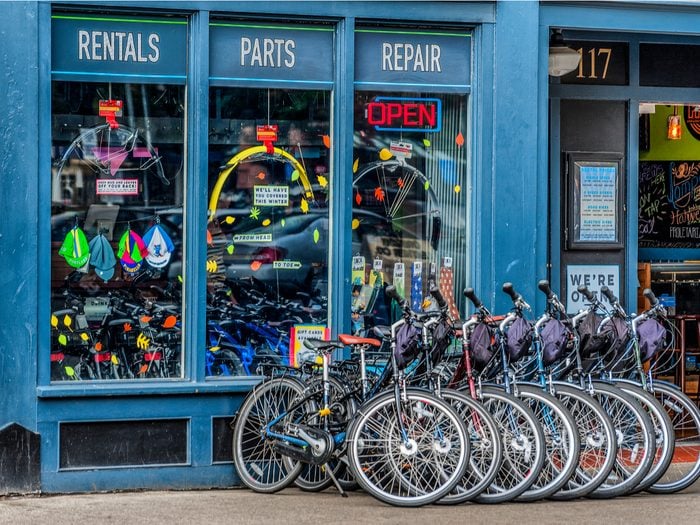
How to Buy a Bike
Looking to get on two wheels this season? Here are some tips on how to buy a bike to ensure you get the right model to meet your needs.
Types of Bikes
-
- Mountain Bikes: Mountain bikes are for the cyclists that like to bike off the beaten path. With at least a dozen gears, rides up and down hills can be managed. Also, mountain bike frames are typically fitted with hardware that help absorb shocks, making bumpy dirt roads a little easier to handle. Great as these bikes might be for off-roading, their bulky size is less ideal for the city commuter or casual cyclist.
- Road Bikes: If you’ve ever tuned into the Tour de France, you’ve seen these types of bikes. With curved handlebars, high seating, and skinny tires, they’re incredibly lightweight, aerodynamic, and pleasing to the eye. These bikes are meant to be ridden only on smoothly paved roads. For someone who prefers higher-speed commutes in the bike lane, the road bike is a great choice.
- Hybrid Bikes: Hybrid bikes marry the best qualities of mountain bikes and road bikes—more sturdy tires but still relatively lightweight—making for a versatile choice. So for everyday commuters and casual cyclists, a hybrid bike is a usually the best option. A hybrid’s upright handlebars will keep you in a relaxed, upright position rather than leaning forwards as you would on a mountain bike or road bike. And some have front-tire suspension, ensuring a smooth commute on the bumpier paved roads.
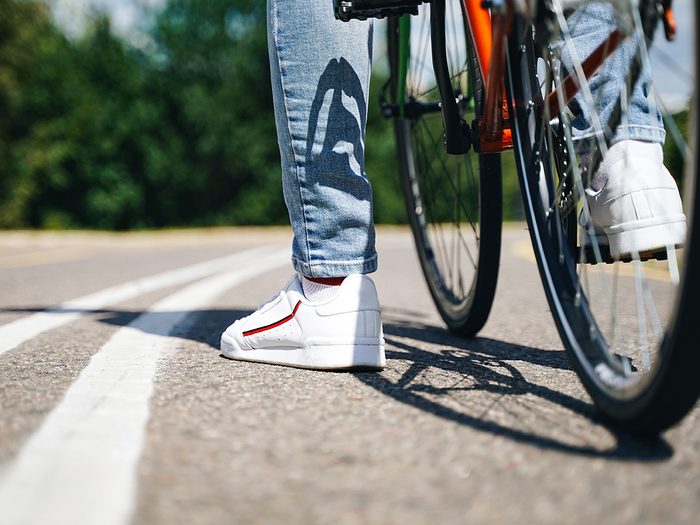
How to Choose the Right Size
After narrowing down your search to a specific make and model, you’ll want to make sure you get the right sized bike. According to Jef Simmons at Montreal’s Cycles Union, you should be able to plant your feet on the ground when you stand with the bike frame’s top tube between your legs, allowing for about 1-2 inches of space between yourself and the tube. You should then adjust the bike seat so your legs have only a slight bend to them when your bike pedals are closest to the ground. Refer to this helpful bike size chart before you start shopping.
Don’t miss our beginner’s guide to bike commuting.
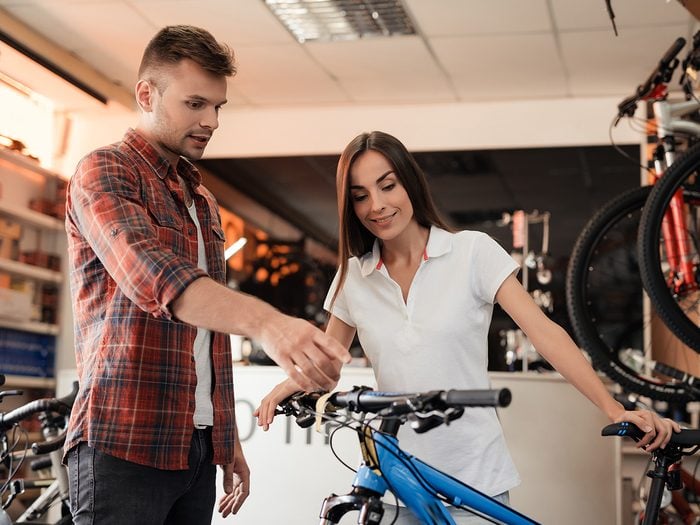
How Much Are You Willing to Spend?
New bikes can range in price from a few hundred dollars to more than a thousand. For regular use, Simmons says making a larger investment—between $500 and $1000—will probably mean you’ll be able to use the bike for twice as long. If a daily commuter looks after their bike, it has the potential to last decades. Annual tune-ups and as-needed investments in replacement parts will ensure the bike stays in rideable shape.
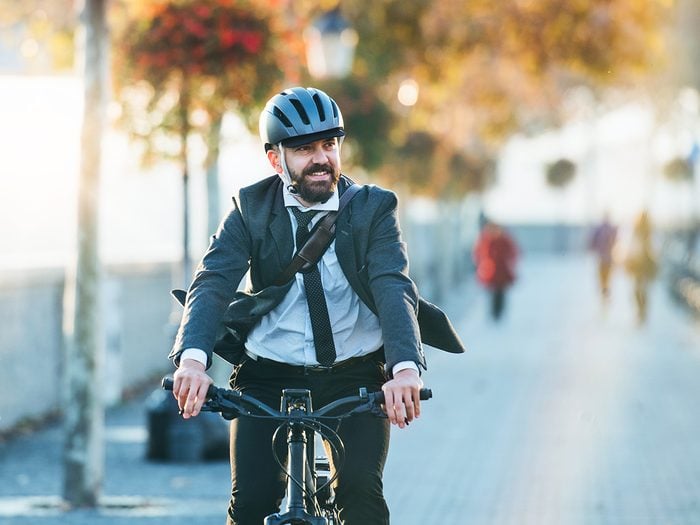
What Bike Accessories Will You Need?
Bike Helmet
Of all the cycling-related injuries that occur, head injuries are the most common. Given what we know about a helmet’s ability to reduce risk of these injuries, it only makes sense that you should invest in a good one. They come in different shapes based on need:
- Commuter bike helmets (less aerodynamic, lightweight)
- Road bike helmets (aerodynamic, ventilated)
- Mountain bike helmets (added sun visor, larger rear-section for added protection)
Lights
Dustin Smith at Bikes & Beyond in Winnipeg suggests every bike owner invest in lights. Lights fall into two categories, he says: “to see and to be seen.” That is, lights that make the roads and paths more visible to you, and lights that make you more visible to motorists, pedestrians, and other cyclists. Be sure get both. In some cities, cyclists are required by law to have at least one white headlight and one red tail-light.
USB rechargeable lights are an affordable—and durable—option. And be sure to point your front headlight downwards to avoid blinding other cyclists!
Bike Lock
No one wants to have their bike stolen, but it happens—a lot. In 2020, nearly 4,000 bikes were reported stolen in Toronto alone—but countless others go unreported, of course. Ward off thieves by investing in a good bike lock. Sold Secure is an independent product certification agency that rates locks based on how difficult it is to break them. Rated companies display their Sold Secure rating on the lock’s packaging. City dwellers should invest in a lock with a “Gold” rating. Most of the time these will be U-locks, though some chain locks will also have Gold ratings.
For a slightly less secure but still effective option, Simmons suggests a folding lock. They aren’t as strong as U-locks, but they’re better than the easy-to-dismantle cable locks.
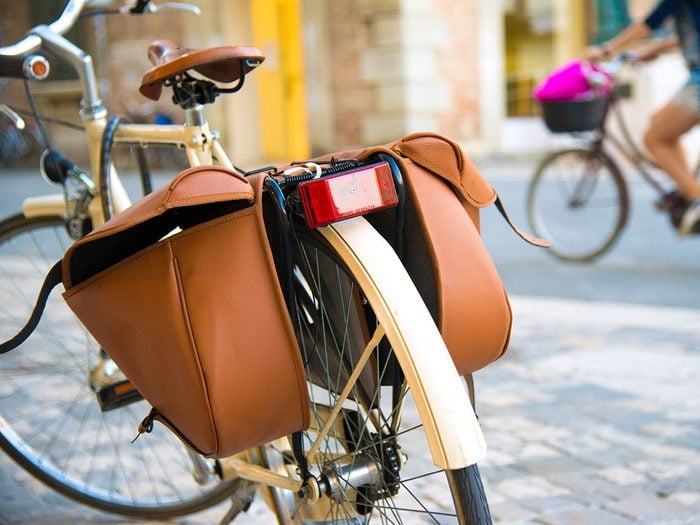
Additional Bike Accessories You Might Consider
Mud Guards
Mud guards—or fenders—are great for cyclists who are determined to hit the road rain or shine. If you’re in Vancouver—also known as “Raincouver”—you’ll definitely need them, says the team at West Point Cycles.
Pannier or Basket
Panniers are the luggage bags that you see slung on a rack that sits over the back tires of bicycles. They are the ideal choice for people commuting to and from work with their laptop, lunch, and everything else they need for the day. Be sure to seek out a waterproof pannier if you expect to be biking on rainy days.
Unlike a basket attached to the front of a bike, panniers evenly distribute weight to both sides of the bike. As accessible and attractive as baskets can be, if it’s overflowing with groceries or heavy objects, it can make for a wobbly biking experience. Choose a basket only if you intend on using your bike for casual rides where you won’t need to carry much.
Kickstand
Speaking of a luggage rack, make the job of packing it up easier with a kickstand. For heavier loading, Simmons recommends a two-legged central stand—it will keep the bike fully upright during the loading process.
Water Bottle Holder
Whether you find yourself biking great distances through the city, rural trails, or you only commute to and from work, a bottle holder will always come in handy. You’ll find most bottle holders attached to the main frame of the bicycle.
Bike Pump
Bike journeys feel their best when you have tires full of air. To save yourself a trip to the nearest bike shop or gas station, invest in a bike pump of your own. For the more serious cyclists, there are mini-bicycle pumps that fit in your bag.
Check out the world’s most bike-friendly destinations.
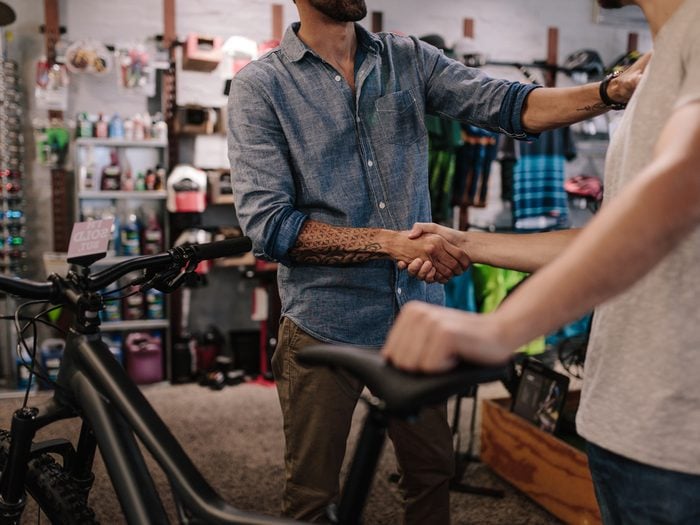
How to Buy a Bike Secondhand
To save some money, a used bike can be a good way to go—and you won’t necessarily have to sacrifice quality. Even a 30-year-old bike can ride like a dream if the seller has been mindful of rust and consistently replaced its pedals, brake lines, and other hardware.
There are two ways to go about buying a used bike: by visiting a local bike shop, or searching online classified ads.
Buying a Used Bike from a Bike Shop
Prices on secondhand bikes at your local shop are a little higher than you’ll see at a garage sale. However, these bikes, usually serviced by a bike mechanic, come with peace of mind (and maybe even a warranty, too).
However, the like-new appearance of a secondhand bicycle at a bike shop can sometimes convince people to buy it, even when it’s not the right type of bike or right size. Smith advises against this impulse. Don’t just get the first affordable bike you find, he says. Test out the bike and don’t hesitate to ask questions.
Buying a Used Bike from Private Sellers
We all love finding a bargain on Kijiji or Craigslist, but it’s important to keep in mind that the bike you buy from a private seller might not be in great condition. To make sure you’re not purchasing a low-quality bicycle, give it a spin around the block before you walk away with it. Better yet, bring a bike-savvy friend along to see the bike. Also, keep these tips in mind:
Do the wheels wobble as they spin? Spin each wheel and look between the brake pads. If the wheels are wobbling, you may have to replace them—a cost that starts at $125, but could be more.
Is the frame bent? The wheels on an unbent frame will be perfectly aligned with one another. Take a close look at the wheels to see you notice any bend in the bike frame.
Are the bearings loose? Bikes rely on small, encased sets of ball bearings to reduce friction in the bike’s moving parts, such as the wheels, pedals, and handlebars. While you would have to disassemble these components to see the bearings for yourself, the bike usually lets you know there is a problem. Spin the pedals, move the handlebars from left to right, and turn the wheels to see if they move freely or are stiff. Bearing problems are a sign the bike has not been serviced in some time.
Also take a look at the hardware. Does it look like you’ll have to replace the pedals, the seat, or other components any time soon? These things should be factored into the price. A bike bought on the private market might have a great price-tag, but after replacing the hardware, it can cost a pretty penny. (These tips on how to haggle could come in handy.)
Watch out for Stolen Bicycles
Bike thieves run rampant in big cities, and a lot of those stolen bikes wind up for sale on the private market.
If you want to avoid purchasing a stolen bike, check out Garage 529, a national bike registry where people log their bicycles by brand, model and serial number. Also, many locales have Facebook groups where people will post photos of their bicycle if it has been stolen. Be sure to log your bike on the Garage 529 registry upon purchase—it could come in handy in the future!
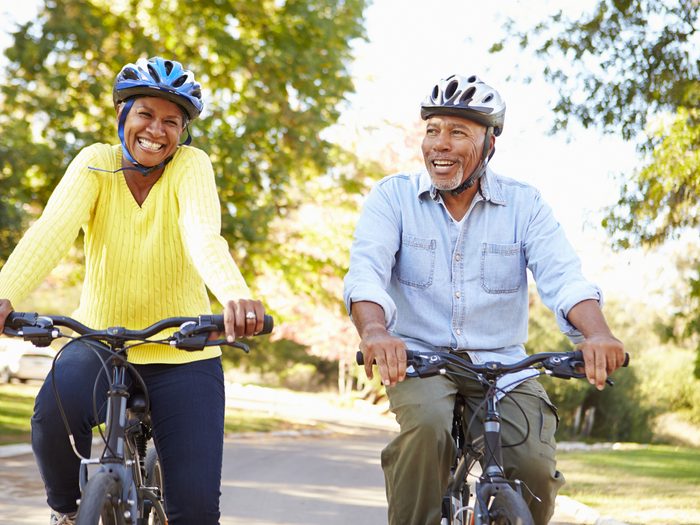
The Best Time to Buy a Bicycle
Bike shops seem to be busier than ever these days, but they’ll always be a little less hectic in the quiet months of the winter when fewer people are riding. Simmons says that most bike shops typically receive their bikes in the late winter and early spring. If you’re looking for one of the latest models, that’s a great time to start shopping. If you’re looking to score a deal, try visiting a shop around the end of the year. That’s when you will see sellers trying to get rid of older models to free up space for the coming year’s shipments.
Now that you know how to buy a bike, start exploring the best bike trails across Canada.